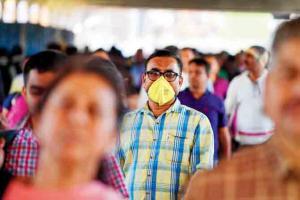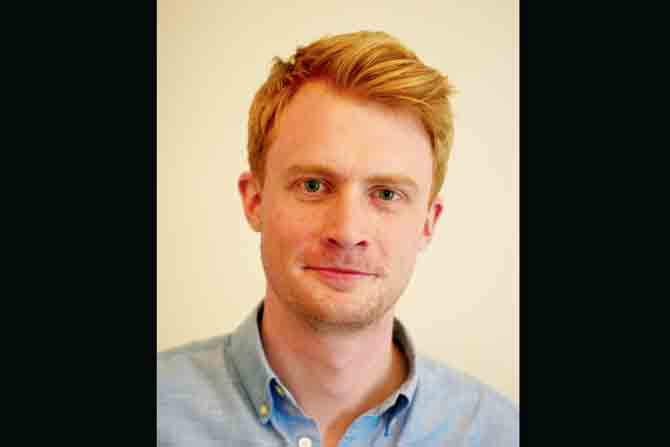The man, who began researching a book on how and why infections spread four years before the coronavirus pandemic, suggests continued social isolation until a vaccine comes

India is currently under a 21-day lockdown. Pic/AFP
It is an eerie coincidence that Adam Kucharski's book, The Rules of Contagion: Why Things Spread and Why They Stop, was released in Britain right before the coronavirus outbreak of December 2019. "I began work in 2016. It is unfortunate that it released at a time like this, when the world is battling a deadly virus," Kucharski, associate professor and Sir Henry Dale Fellow at the London School of Hygiene and Tropical Medicine, says in a Skype interview. "But, in a way, I am glad the book, which addresses the underlying principles that drive contagion, will create awareness."
ADVERTISEMENT
Kucharski is a TED fellow, winner of the 2016 Rosalind Franklin Award Lecture and the 2012 Wellcome Trust Science Writing Prize and the author of The Perfect Bet: How Science and Maths Are Taking the Luck Out of Gambling. His latest work explains what makes things spread, why outbreaks look like they do, and how we can change what happens in the future. Kucharski uses math to understand the outbreak of Ebola, SARS, influenza, and now COVID-19. With statistics flying around, what are the ones that need our immediate attention? "The number of cases reported is dependent on how many people are tested. Often, stats don't reflect actual numbers. So, it is only and only the number of fatalities that determines the [extent of] transmission of the disease," he explains. He clarifies that if a death has occurred today, it means the infection occurred at least a month ago. "There is a delay from transmission to outcome [death]. So it is only figures of death that need our attention."
Kucharski stresses on the need to learn from previous outbreaks. In the book, he writes: "One outbreak won't necessarily look like another. What we need is a way to separate features that are specific to a particular outbreak from the underlying principles that drive contagion. A way to look beyond simplistic explanations, and uncover what is really behind the outbreak patterns we observe."

Adam Kucharski
But with COVID-19, what can we possibly learn from history? "If you look at the malaria outbreak, people had very strong and incorrect opinions around what it was. Some even thought it wasn't spreading. Now, with coronavirus, there are people who say it is just flu and that it won't be bad. But we cannot make the same mistakes again. We need to take this very seriously."
Despite global lockdowns and sealing of borders, he isn't convinced enough has and is being done. They started with temperature screenings at the airport but of say, the 100 infected persons arriving, only a few will show a fever or any symptom. Which means the machine won't pick up potential cases. "China, for example, closed its borders. That slowed down the spread outside of the country. But within China, it only slowed down for a few days, and then it peaked again. You ought to be aware that you think a control measure is effective, but it may not always be."
The best time to intervene according to him, is in the early stages. "For one reason or the other, the early numbers in Wuhan were not taken seriously. The figures were not immediately communicated to the WHO. If this would have been done, the medical experts would have been able to control the spread."
Singapore, according to Kucharski, did an effective job in addressing this pandemic. "Every country has its limitations. But Singapore did a fantastic job. They have a high-trusted government and a great setup to handle this virus."
Singapore's response to the infection has been held up by many across the world. The country has recorded two deaths and the infection spread rate is much slower than the rest of the world. What helped was that they were ready before the outbreak even occurred, because of their experience with dealing with SARS in 2002-03. They realised they didn't have the infrastructure to fight the outbreak. So in the next few years, isolation hospitals were built, more negative pressure rooms were created and legislation was put in place. Finally, when the world became aware of COVID-19, Singapore was ready.
So what does the future hold for the world? An unpleasant time, Kucharski thinks. "From the health point of view, quarantine and self isolation can reduce transmission. But we can't be in lockdown for a year; [it will carry on] for two to three months at best. And once the controls are lifted, countries will be at risk of more transmission. If this outbreak recurs in a few months, we will be back to square one. And the possibility of this happening is very high."
All you can do, he says, is wash your hands, ensure minimal social interactions, and stay indoors till a vaccine is found.
Catch up on all the latest Mumbai news, crime news, current affairs, and also a complete guide on Mumbai from food to things to do and events across the city here. Also download the new mid-day Android and iOS apps to get latest updates
 Subscribe today by clicking the link and stay updated with the latest news!" Click here!
Subscribe today by clicking the link and stay updated with the latest news!" Click here!






